How to Mine Digibyte (DGB): Complete Beginners Guide
Digibyte (DGB) is a rapidly growing and increasingly popular blockchain that was designed for speed and security in making decentralized payments.
Currently used in over 100 countries it comes with many cutting edge features for cryptocurrencies. These include minimal and even nonexistent fees as well as lightning-fast transaction speeds.
Unlike other cryptocurrencies that can take many minutes, or even hours in some cases, you are able to send Digibytes to any other Digibyte address anywhere in the world within seconds. And there’s no need to register, and no hidden fees to contend with.
To make the blockchain even more attractive, Digibyte can be used to secure data, including documents and contracts, in ways that have never before been possible.

Another great feature of Digibyte is that you can still mine it using your computer’s GPU, especially if you join a mining pool to combine your mining power with that of other Digibyte enthusiasts. In fact, Digibyte followed in the footsteps of Monero earlier this year, hard forking the blockchain to remain resistant to ASIC mining on some of the algorithms that can be used to mine Digibyte.
This How to Mine Digibyte Guide will walk you through everything you need to know to mine Digibyte, so let's get right into it.
What is Digibyte Mining?
Mining Digibyte is the act of securing the network, validating blocks, and bringing new Digibyte tokens into circulation. Digibyte was originally a fork off the Bitcoin blockchain, and like Bitcoin it uses a consensus mechanism known as Proof of Work (PoW). PoW is considered to be the most secure consensus protocol for blockchains.
Minng is accomplished by using the processing power of your computer to solve cryptographic problems. This validates blockchain transactions, secures the Digibyte network, and ultimately creates new blocks while also rewarding miners with Digibytes. In addition to a computer with a GPU you’ll also need a Digibyte wallet and specialized mining software to mine Digibyte.
Digibyte Mining Algorithm Choices
Digibyte is somewhat unique among cryptocurrencies as it allows you to mine with five separate algorithms. The algorithms supported for mining include SHA-256, Skein, Groestl, Scrypt and Qubit. The choice of which algorithm to use is primarily dictated by the mining hardware being used.
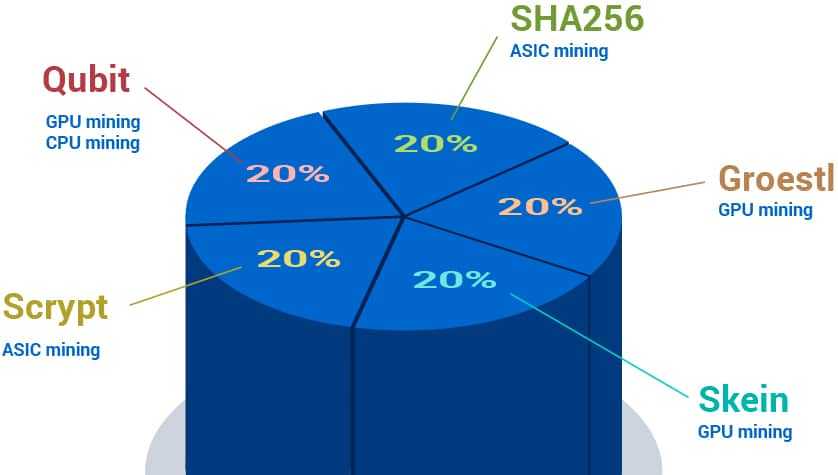
The SHA-256 and Scrypt algorithms are dominated by ASIC miners and aren’t suitable for home mining rigs. Qubit uses a combination of multiple types of hardware and is best for more advanced users. And Groestl and Skein are best for GPU mining.
Solo or Pooled Mining
When you get started mining Digibyte you have a choice between solo mining on your own mining rig or pooled mining where you join a group of other Digibyte miners. The pooled mining method is by far the most popular method.
In a mining pool a group of individuals join their resources, or hash power, which allows them to find more blocks, and gather more mining rewards. The rewards are then split evenly between the participants in the mining pool based on how much processing power they are adding to the pool.
Solo mining is done on your own, and because mining difficulty has increased so much it is often likened to buying a lottery ticket because you have a very low probability of being the first to solve a block. Of course you don’t have to share the reward when solo mining, but it could take months or longer to find a block.
Mining pools are superior because you are making coins every single day.
Getting Started Mining Digibyte
The following guide on how to mine Digibyte on a Windows 10 PC using either an Nvidia or AMD GPU. It is also based on joining a mining pool, since this is really the best way to generate a steady supply of Digibyte tokens.
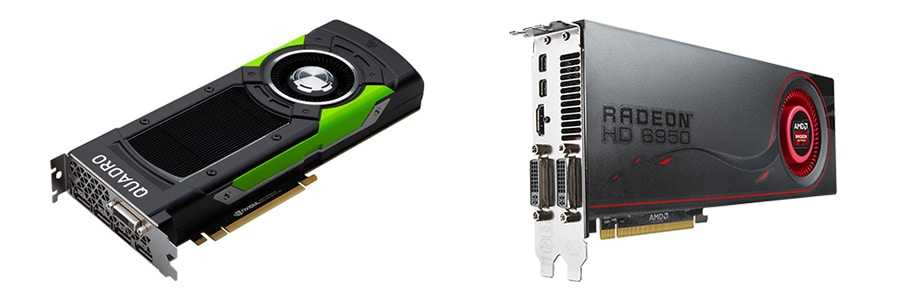
Before you decide on a pool to mine Digibyte with you’ll want to make sure you have a wallet, because the pool will be asking you for your wallet address (and you need a place to keep your Digibyte anyway). If you already have a Digibyte wallet, great! If not, you can download official and third-party Digibyte wallets from the official Digibyte website. And while I don’t recommend it, you could also mine directly to an exchange wallet if you have an account at one which supports Digibyte.
Now it’s time to choose a Digibyte mining pool. Your pool choice is going to be dictated by which algorithm you’ll be using to mine. As mentioned above, the best choice for GPU mining is either Skein (Nvidia cards) or Groestl (AMD cards). Below are the DGB mining pools available for each algorithm:
Groestl Mining Pools
Skein Mining Pools
- DigiHash
- TheBlocksFactory
- MiningField
Scrypt Mining Pools
SHA256 Mining Pools
Qubit Mining Pools
Note that DigiHash is the first mining pool listed for each algorithm. This is by design because DigiHash is supported by the Digibyte Foundation, and part of the rewards go back to maintaining the network. Many people avoid using the pool though because of the 5% mining fee that’s assessed.
Also note that to be able to mine in certain pools, you need to optimize the miners with Myriad-Groestl which is DGB algorithm. It is also the most profitable way to mine Digibyte currently. You can get the optimized miners at The Blocks Factory
AMD – http://theblocksfactory.com/sgminer-5-0-1-windows-gr.zip
Nvidia – http://theblocksfactory.com/ccminer-1.2-myr-gr.zip
Because I have an Nvidia card I’ll be using MiningField with the Skein algorithm for the rest of this tutorial.
Create Your First Worker
The first thing you obviously need to do is register an account at MiningField and then log in. Next you’re going to create your first worker. Go to the “My Account” link on the left, click it and then click “My Workers” to begin creating a new worker.

Go to the bottom of the MiningField page and you'll see a form titled “Add New Worker”. Enter your desired Worker Name and Worker Password and click the “Add New Worker” button. You now have a worker in the mining pool (you'll see it in the "Worker Configuration" to the right) and are ready to download and set-up the mining software.

Download and Configure Mining Software
Next you’ll need to download mining software. If you have an Nvidia card it’s best that you use CCMiner, but if you have an AMD card then the Claymore miner is best. You can download either of them from GitHub. Once you’ve downloaded the appropriate mining package zip folder you need to extract it to a folder on your PC.
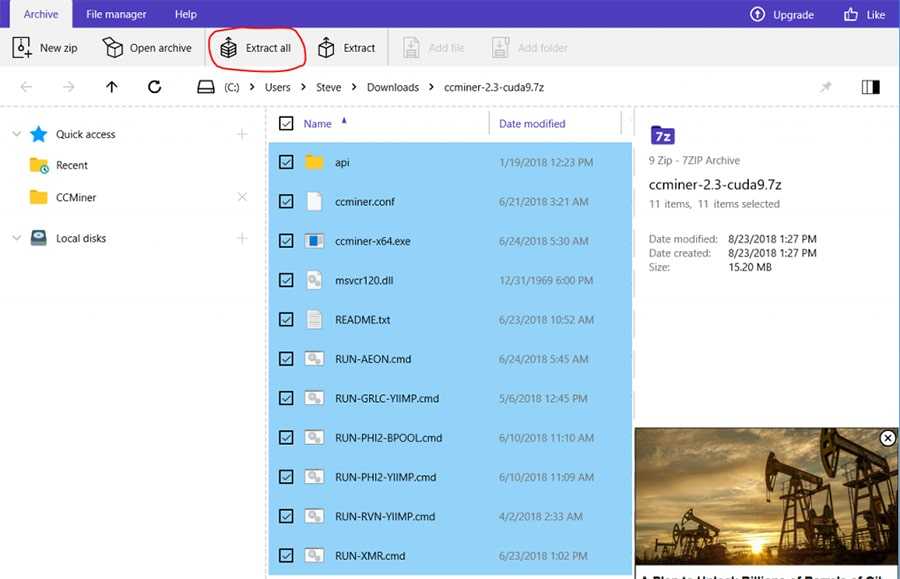
Next you need to create the config file for CCMiner that tells it where the mining pool is and your account information there. This file will be saved as a .bat file, but you’ll create it using Notepad, so it really isn’t too complicated. Go ahead and open Notepad. Now, copy and paste the following information, replacing “username” with your username, worker with your workers name and “yourpassword” with your worker password.
ccminer-x64 --algo=skein -o stratum+tcp://eu.miningfield.com:3398 -u username.worker -p yourpassword
Example: username.worker
“username” is the username you created at Miningfield when you registered and “worker” is the worker name you created earlier in this tutorial.
Next modify the URL to any of the Stratum ports listed on the MiningField site.
Example: “url” : “stratum+tcp://us.miningfield.com:3397”
Finally we will save the .bat file to the same folder where you extracted the mining software.
To create a . bat file, simply open up notepad and save the file in the same folder as your mining software with a .bat extension ( change “save as type” from text to All files. The file name can be anything at all, but needs to include the .bat extension). Click “Save”.
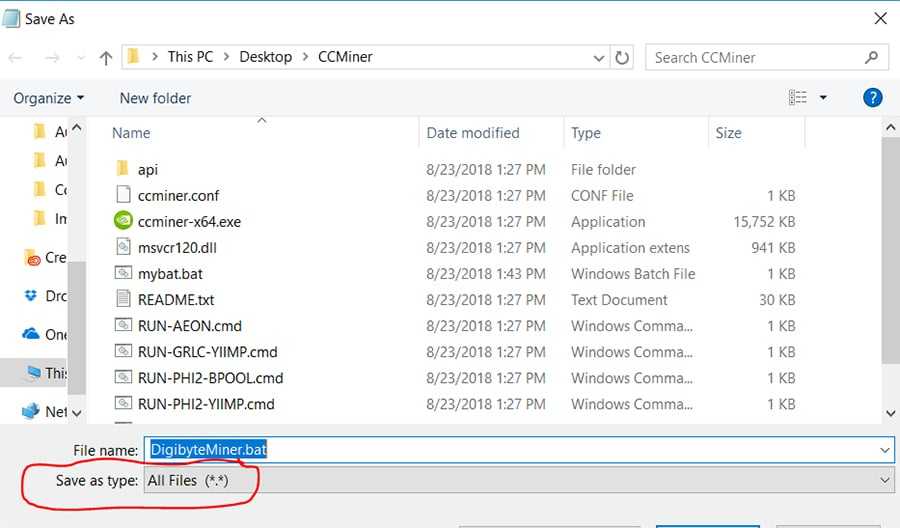
Start Mining
Run the .bat file you created which will start the CCminer application, and if everything is set-up properly you’ll begin to see the lines that begin “accepted” and end “yes!”. That means you’re mining and receiving DGB.
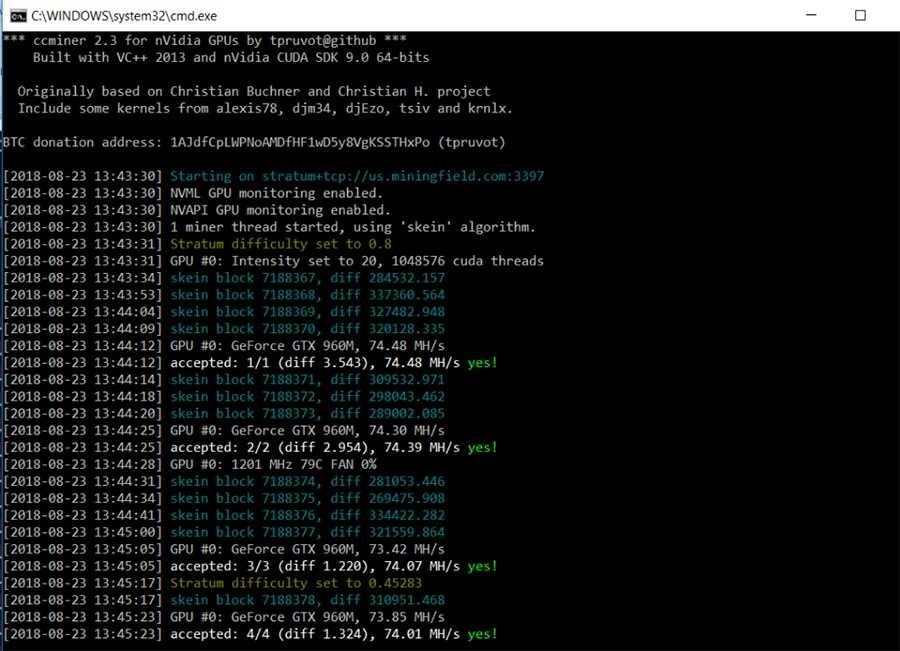
Conclusion
Digibyte mining is an excellent way to get started with cryptocurrency mining because it is one of the few top coins that can still be mined using the GPU and CPU in your own computer. It’s also an excellent coin to mine because the mining application can run without causing your computer to slow down. This means you can continue working in other programs, which isn’t always true when mining cryptocurrencies.
So, now you’re set-up for mining with your GPU you might also be interested to know that the MiningField pool will also allow you to mine with your CPU. I haven’t included instructions though, because most people don’t think CPU mining of Digibyte is profitable.
Frequently Asked Questions
Digibyte is a blockchain designed for fast and secure decentralized payments. It's popular for mining due to minimal fees, lightning-fast transaction speeds, and the ability to mine using GPUs, making it accessible to a broad audience.
Mining Digibyte allows individuals to secure the network, validate blocks, and earn new Digibyte tokens. Benefits include minimal fees, fast transactions, and the ability to use Digibyte for securing data, including documents and contracts.
Digibyte mining involves using computer processing power to solve cryptographic problems, validate transactions, secure the network, and create new blocks. It follows a Proof of Work (PoW) consensus mechanism similar to Bitcoin.
Profitability depends on factors such as hardware efficiency, electricity costs, and market conditions. Mining Digibyte with GPUs can still be profitable, especially when joining mining pools.
Some mining pools, such as DigiHash, may charge a mining fee (e.g., 5%). Users should check the fee structure of their chosen mining pool and factor it into their mining profitability calculations.
Disclaimer: These are the writer’s opinions and should not be considered investment advice. Readers should do their own research.


